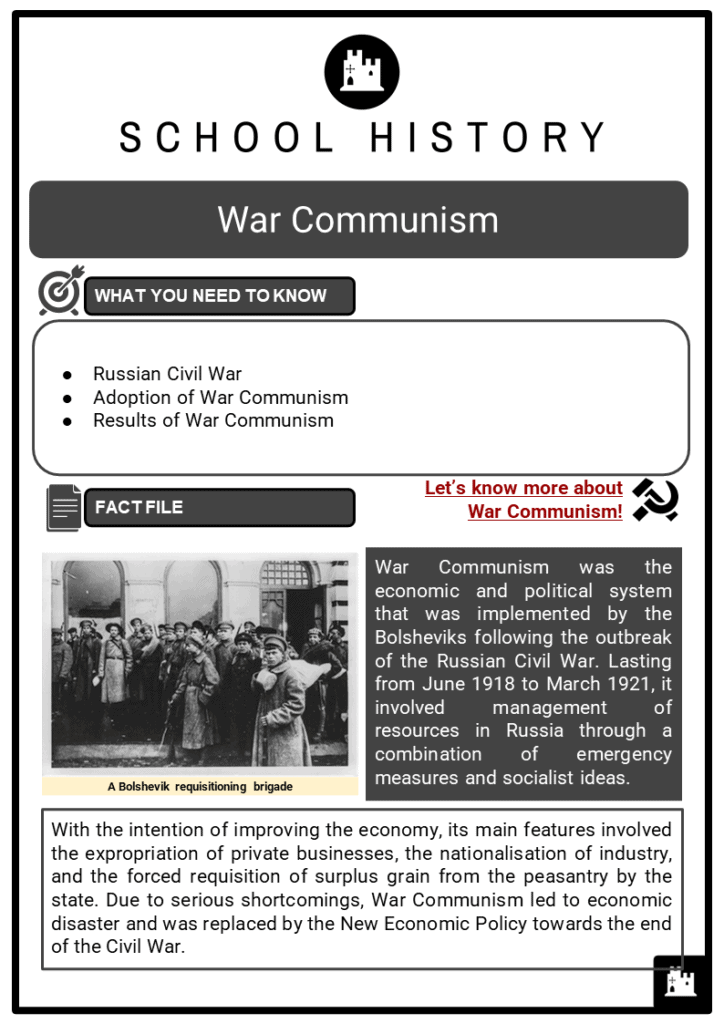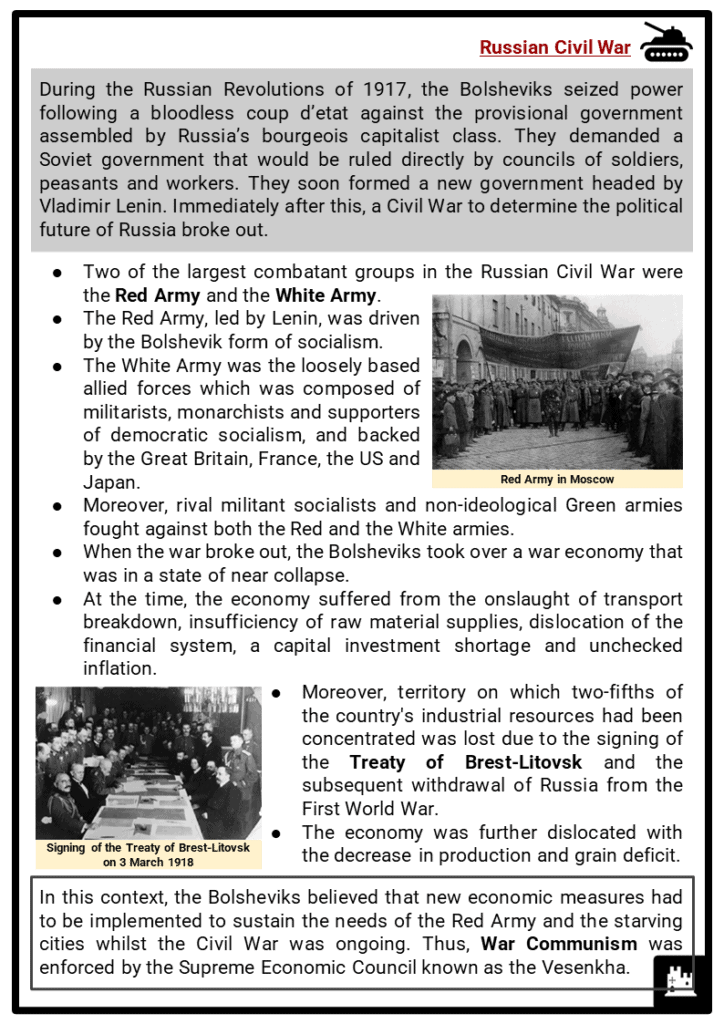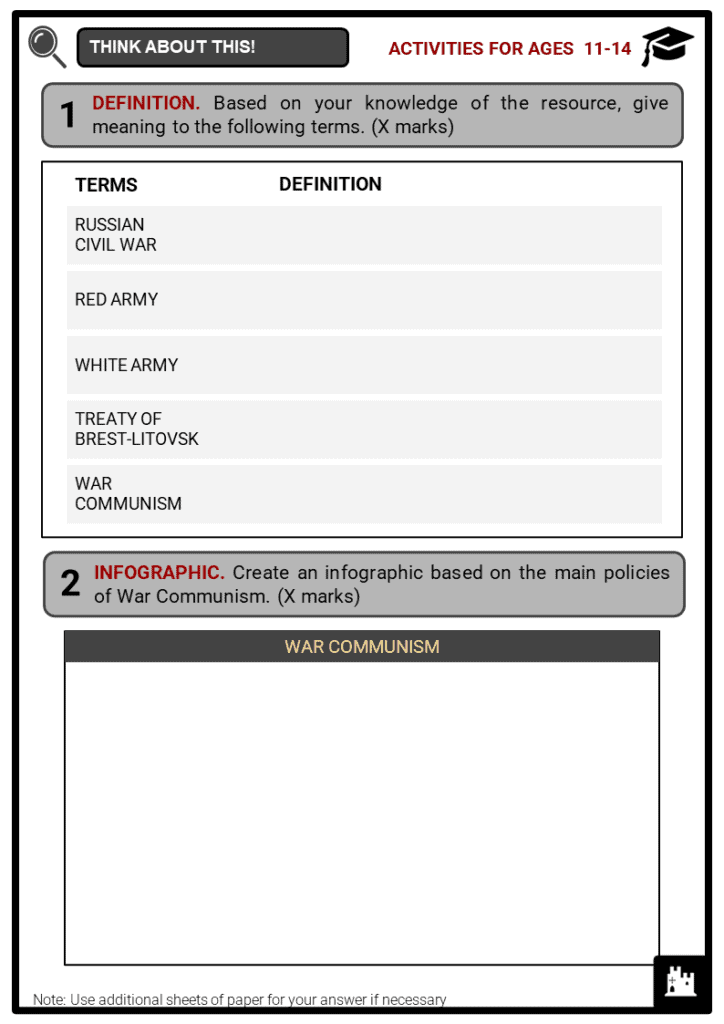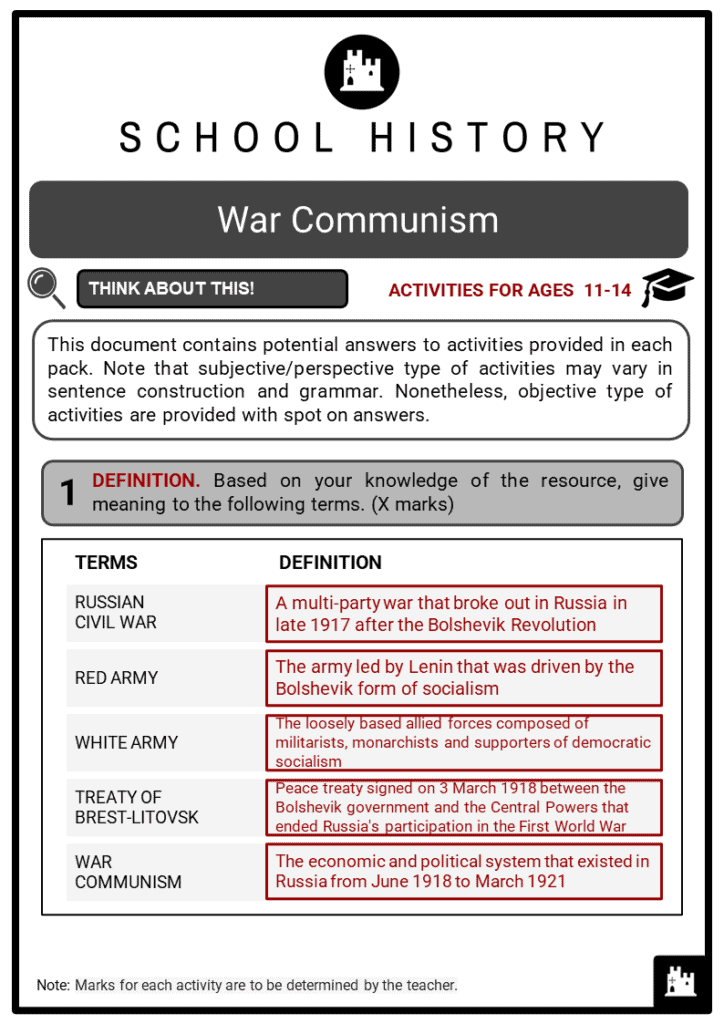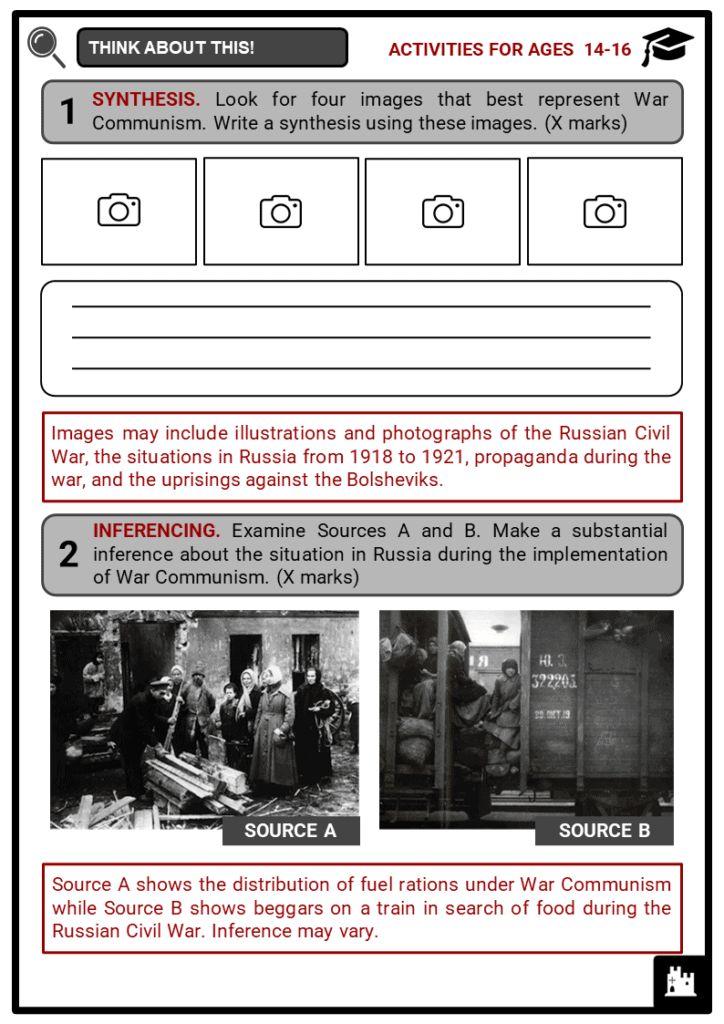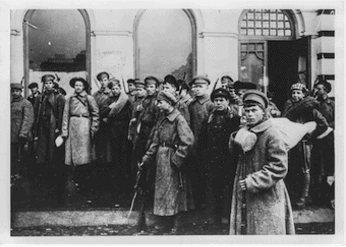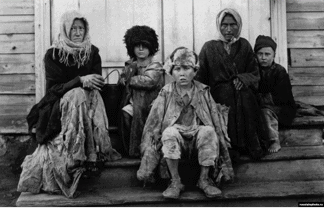Download War Communism Worksheets
Do you want to save dozens of hours in time? Get your evenings and weekends back? Be able to teach War Communism to your students?
Our worksheet bundle includes a fact file and printable worksheets and student activities. Perfect for both the classroom and homeschooling!
Table of Contents
Add a header to begin generating the table of contents
Summary
- Russian Civil War
- Adoption of War Communism
- Results of War Communism
Key Facts And Information
Let’s know more about War Communism!
- War Communism was the economic and political system that was implemented by the Bolsheviks following the outbreak of the Russian Civil War. Lasting from June 1918 to March 1921, it involved management of resources in Russia through a combination of emergency measures and socialist ideas.
- With the intention of improving the economy, its main features involved the expropriation of private businesses, the nationalisation of industry, and the forced requisition of surplus grain from the peasantry by the state. Due to serious shortcomings, War Communism led to economic disaster and was replaced by the New Economic Policy towards the end of the Civil War.
Russian Civil War
- During the Russian Revolutions of 1917, the Bolsheviks seized power following a bloodless coup d’etat against the provisional government assembled by Russia’s bourgeois capitalist class. They demanded a Soviet government that would be ruled directly by councils of soldiers, peasants and workers. They soon formed a new government headed by Vladimir Lenin. Immediately after this, a Civil War to determine the political future of Russia broke out.
- Two of the largest combatant groups in the Russian Civil War were the Red Army and the White Army.
- The Red Army, led by Lenin, was driven by the Bolshevik form of socialism.
- The White Army was the loosely based allied forces which was composed of militarists, monarchists and supporters of democratic socialism, and backed by the Great Britain, France, the US and Japan.
- Moreover, rival militant socialists and non-ideological Green armies fought against both the Red and the White armies.
- When the war broke out, the Bolsheviks took over a war economy that was in a state of near collapse.
- At the time, the economy suffered from the onslaught of transport breakdown, insufficiency of raw material supplies, dislocation of the financial system, a capital investment shortage and unchecked inflation.
- Moreover, territory on which two-fifths of the country's industrial resources had been concentrated was lost due to the signing of the Treaty of Brest-Litovsk and the subsequent withdrawal of Russia from the First World War.
- The economy was further dislocated with the decrease in production and grain deficit.
- In this context, the Bolsheviks believed that new economic measures had to be implemented to sustain the needs of the Red Army and the starving cities whilst the Civil War was ongoing. Thus, War Communism was enforced by the Supreme Economic Council known as the Vesenkha.
Adoption of War Communism
- To combat the economic problems exacerbated by the rapid descent into Civil War, Lenin introduced War Communism. It was the economic and political system that existed in Russia from June 1918 to March 1921. It was a combination of emergency measures and socialist ideas.
- Why was War Communism introduced?
- The Red Army needed to be supplied with food and weapons to help it win the Civil War against the Whites.
- The Bolsheviks wanted to take control of industry and food production in Russia to reorganise it more equally.
- Major policies of War Communism:
- Nationalisation of land Lenin nationalised Russia by declaring banks and shipping a state monopoly.
- End of private capitalism Lenin passed a decree on 28 June 1918, which ended all forms of private capitalism in Russia. By 1920, major industries in Russia were controlled by the state.
- Abolition of money as a means of exchange It attempted to introduce bartering and a system of natural economy. Most taxes were also abolished.
- Confiscation of private houses Aside from keeping private ownership to a minimum, private houses were confiscated by the state.
- Obligatory labour duty The state controlled the labour of the citizens. Once a unit of the military had served its purpose, it would become a labour army.
- State rationing Food was distributed according to categories of workers: manual, physical, housewives and professional labourers. Any excess food had to be surrendered to the state.
- Introduction of strict centralised management The control of various industries was held by a few organisations. The Supreme Economic Council, being the most significant one, had the right to confiscate and requisition property.
- Since these measures were introduced during the Civil War, problems with implementation occurred, which concerned coordination and communication between regions controlled by the Bolshevik government.
Results of War Communism
- War Communism had varying results in military, social and economic aspects of the country. For its primary purpose of aiding the Red Army against the Whites, it was largely successful. However, it turned out to be a disaster and failed to improve the economy during the Civil War.
- Outcomes of War Communism:
- The policy of having to hand over surplus food caused huge resentment in the countryside.
- With no incentives to grow surplus grain, peasant's grain production decreased as farmers chose to grow crops for themselves.
- Both the peasantry and urban population suffered from starvation, malnutrition and disease despite the introduction of rations.
- Many large factories became useless because of the lack of fuel and skilled labour.
- Labour productivity and industrial output declined as a large and untrained bureaucracy supervised the centralised, state-owned industries.
- With paper currency becoming worthless due to uncontrolled inflation, the government resorted to the exchange and distribution of goods and services without the use of money.
- Believing that moving out to the countryside was better for their survival, many city dwellers did so to grow food for themselves.
- Private trade emerged despite it being illegal.
- In conclusion, War Communism failed to improve both agricultural and industrial production leading to economic disaster.
- Amidst a few anti-Lenin strikes, the Bolsheviks were able to arrest and subdue any potential opposition and trouble.
- Most Russians remained supportive of the policies under the Bolsheviks and felt that the failure of War Communism was to be blamed on the Whites.
- The severity of War Communism could be justified whilst the Civil War was ongoing. However, when the war was coming to a close, violent rebellions of workers and peasants who were angered by the state of the economy threatened Lenin's regime. As a result, War Communism was replaced by the New Economic Policy in June 1921 and the Bolsheviks temporarily abandoned their attempts to achieve a socialist economic system by government decree.
Image sources:

